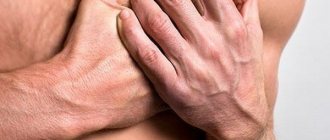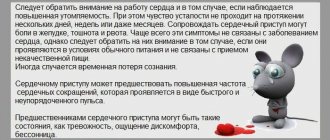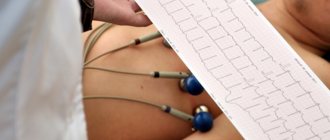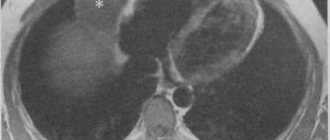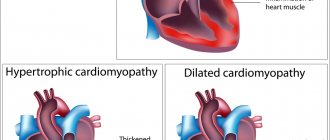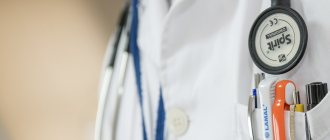Many patients come to the doctor with an “accurate” diagnosis, made independently. Without examination, they are sure that their heart hurts, and they are very surprised and even upset that the doctor does not detect signs of heart disease. On the one hand, this is even good, because people know about the danger and are trying to find out what to do if their heart hurts seriously.
On the other hand, such fear can lead to cardioneurosis, a brain disease in which pain in the heart is also felt.
How does your heart work?
The heart is a unique muscular organ located in the middle of the chest. The heart pumps blood throughout the body, saturating cells with oxygen and nutrients. The muscular septum divides the heart longitudinally into left and right halves. The valves divide each half into two chambers: the upper (atrium) and the lower (ventricle).
As the heart muscle contracts, it pushes blood first through the atria and then through the ventricles. In the lungs, the blood is saturated with oxygen and through the pulmonary veins enters the left atrium, then into the left ventricle and from it, through the aorta and arterial vessels branching from it, it is distributed throughout the body.
Having given up oxygen, the blood collects in the vena cava, and through them into the right atrium and right ventricle. From there, through the pulmonary artery, the blood enters the lungs, where it is again enriched with oxygen. The main indicator of the heart's performance is the amount of blood it must pump in 1 minute. Usually for an adult this is at least 5.0 liters (300 liters per hour, 7200 liters per day).
The heart beats more than 100,000 times a day, pumping blood through the 20,000 km of veins and arteries that make up the human circulatory system.
When an adult is at rest, the heart beats 60 to 80 times per minute. During physical activity, at a time of stress or excitement, the heart rate can increase to 200 beats per minute.
Can the heart adapt to work in hypoxic conditions?
An important property of adaptation to work without sufficient oxygen supply is the anaerobic (oxygen-free) process of energy synthesis. A very rare occurrence for human organs. Turns on only in emergency situations. Allows the heart muscle to continue contracting. Negative consequences are the accumulation of breakdown products and overwork of muscle fibrils. One cardiac cycle is not enough for energy resynthesis.
However, another mechanism is involved: tissue hypoxia reflexively causes the adrenal glands to produce more aldosterone. This hormone:
- increases the amount of circulating blood;
- stimulates an increase in the content of red blood cells and hemoglobin;
- increases venous flow to the right atrium.
This means that it allows the body and myocardium to adapt to the lack of oxygen.
Heart rhythm and conduction disorders
The normal heart rhythm is called sinus rhythm.
The heart has its own electrical (conducting) system, consisting of an electrical impulse generator - the main pacemaker - and conductive pathways connecting the entire electrical circuit. The main pacemaker, located in the right atrium, generates regular electrical impulses at a certain frequency, like a metronome. In response to each impulse, the chambers of the heart contract in strict sequence.
First, a wave of electrical excitation covers the atria, as a result of which they simultaneously contract, throwing blood into the ventricles. Having passed through the atria, the wave does not immediately pass to the ventricles, since they are separated from the atria by tissue that is unable to conduct electrical impulses. In only one small area, a single “bundle of wires” passes through this tissue, through which, after a short delay, the electrical impulse can travel to the ventricles and cause the same wave-like contraction as in the atria. This bundle is called the atrioventricular junction (AV node), and the delay between the contraction of the atria and ventricles is necessary so that the atria have time to “push” blood into the ventricles before the latter begin to contract.
Normally, the atrioventricular junction is the only place in the heart where the transfer of electrical excitation to the ventricles occurs. After this, the electrical impulse spreads through both ventricles, causing them to contract. At the same time, the blood is pushed out of them into the arteries, providing blood supply to all organs of the body and the heart itself.
Thus, a normal heart rhythm differs from an abnormal one in two main features: regularity and a certain frequency. Any disturbance in heart rhythm is always a consequence of dysfunction of the conduction system.
Forecast
Patients with dextrocardia, which does not manifest itself, do not have to worry about their health if they follow recommendations regarding nutrition, giving up bad habits and maintaining physical activity. Their risk of heart failure is the same as that of other people. In such cases, the pathology is considered just an anatomical defect.
In case of multiple deviations in the structure and formation of organs, the prognosis will depend on the type of malformation and the timeliness of its treatment, and the possibilities for radical surgery.
Bradycardia. Slow heart rate
Your heart rate usually beats between 60 and 80 beats per minute.
A reading below 60 beats per minute is called bradycardia. For many people in good physical shape, or if such a rhythm occurs during rest and sleep, then such a rhythm is normal. A distinctive feature of such bradycardia is that with increasing physical activity, the heart rate begins to accelerate, covering the body’s needs with its frequency.
We talk about bradycardia as a disease when the rhythm has a very low frequency, does not respond by increasing frequency to physical activity, or large pauses occur in the rhythmic contraction, which can reach or even exceed more than 2 seconds. Such disturbances lead to fatigue, dizziness and loss of consciousness.
The most common cause of a slow heart rate is:
• Sinus node dysfunction (SU).
• Impaired conduction of the electrical signal from the atria to the ventricles through the atrioventricular node (AV).
When bradycardia is confirmed diagnostically and such a rhythm is the only manifestation, then such a rhythm is effectively corrected by a pacemaker. ICDs can also be used for bradycardia, but only if there are appropriate indications for ICD implantation (life-threatening cardiac arrhythmias).
Symptoms of dextrocardia
The patient may not be aware of the existence of a right-sided location of the heart, since there are no specific manifestations. Such people can give birth to absolutely healthy children, but still the risk of developmental abnormalities is higher than for others.
If dextrocardia is part of a pathological arrangement of organs, then its symptoms can be identified after the birth of the child:
- prolonged jaundice of newborns,
- slow growth and development,
- pallor or cyanosis of the skin,
- rapid breathing and pulse.
Mirror arrangement of the heart (dextrocardia)
Babies are capricious, quickly get tired when feeding, have difficulty gaining weight, and often suffer from colds. Upon examination, the apex beat of the heart is found on the right side of the sternum, the boundaries are shifted, the liver is located under the left costal arch, and the stomach and spleen are on the right.
When listening to the heart and lungs, unusual localization of tones and breathing sounds is noted.
Watch the video about heart defects and their types:
Tachycardia
If your heart rate exceeds 100 beats per minute, it is called tachycardia. Tachycardia can be sinus and belong to normal, physiological tachycardia. Tachycardias with a high frequency, which exceed 180 beats per minute, arising in connection with frequent, group extrasystole, additional conduction pathways are classified as a group of non-normal fast heart rhythms.
Physical activity, emotional stress, and certain diseases can cause an accelerated heart rate that exceeds 100 beats per minute.
When your heart rhythm is very fast or your heart beats for no reason at a high frequency and irregularly, it is called tachyarrhythmia.
Pathological tachycardia is harmful for several reasons. Firstly, with a rapid heartbeat, the efficiency of the heart decreases, since the ventricles do not have time to fill with blood, as a result of which blood pressure drops and blood flow to the organs decreases. Secondly, the conditions of the blood supply to the heart itself worsen, since it does more work per unit of time and requires more oxygen, and poor conditions of the blood supply to the heart increase the risk of coronary disease and subsequent heart attack.
Tachycardia is not a disease, but a symptom, since it can occur as a manifestation of many different diseases. The most common causes of tachycardia are disorders of the autonomic nervous system, endocrine system disorders, hemodynamic disorders and various forms of arrhythmia.
Treatment methods
Treatment depends on whether dextrocardia is accompanied by other cardiac pathologies. If not, then therapy is not required. The patient can lead a full active life. Only when deciding to engage in sports is it recommended to undergo an ECG.
If the incorrect location of the heart occurs along with other diseases, treatment tactics will depend on the specific diagnosis. Typically, heart defects are eliminated through surgery, during which the existing defects are removed.
Before the operation, the patient must be prepared by prescribing medications. To maintain the patient's condition, diuretics, antihypertension agents, and drugs that support the myocardium are used.
Special attention is paid to antibacterial treatment. It is carried out both before surgery and during the period of rehabilitation of the body after it. But taking antibiotics for a long time is not recommended, as they negatively affect the condition of the organs.
Any medications are prescribed exclusively by the attending doctor, taking into account the results of the patient’s examination. The specific list of medications depends on the type of disease and the severity of its course.
Tachyarrhythmia
This is an abnormally fast heart rate (usually 100 to 400 beats per minute, which occurs either in the upper chambers of the heart (atrial fibrillation, supraventricular tachycardia) or in the lower chambers (ventricular fibrillation, ventricular tachycardia)).
Causes of tachyarrhythmia:
• Heart diseases such as high blood pressure, coronary artery disease (atherosclerosis), heart valve disease, heart failure, cardiomyopathy, tumors and infections.
• Other medical conditions, such as thyroid disease, some lung diseases, electrolyte imbalances, and alcohol and drug abuse.
• Caused by abnormal accessory pathways or extrasystoles.
Tachyarrhythmias occur when the impulse contracting the heart muscle arrives earlier than normal heart rhythm would suggest. Tachyarrhythmias can begin in the upper or lower chambers of the heart.
Tachyarrhythmia includes various types of cardiac arrhythmias:
• Supraventricular tachycardia.
• Ventricular tachycardia (VT).
• Ventricular fibrillation (VF).
Supraventricular tachyarrhythmias
Rhythm disorders involving the atria are called supraventricular (supraventricular) arrhythmias. This group of rhythm disturbances is the most common, and it is the one that doctors and patients have to deal with most often. There are 5 main types of supraventricular arrhythmias:
• atrioventricular nodal tachycardia;
• Wolff-Parkinson-White syndrome;
• intraatrial tachycardia;
• atrial flutter;
• atrial fibrillation.
Atrial fibrillation (AF)
Atrial fibrillation is the most common arrhythmia, usually a manifestation of other heart diseases (coronary heart disease, valvular disease, myocarditis, etc.) or metabolic disorders (thyrotoxicosis, electrolyte imbalance, etc.). Sometimes it occurs without an obvious cause, and then it is called idiopathic.
The mechanisms of development of atrial fibrillation are still not fully understood. In some patients, it occurs due to the presence of many chaotic circular waves of electrical excitation in the atria.
Atrial fibrillation is usually treated with medications that maintain a normal rhythm or prevent the heart rate from getting too fast. A prerequisite for atrial fibrillation is the use of anticoagulant therapy. It is used to thin the blood to prevent the formation of blood clots.
For the surgical treatment of atrial fibrillation, the method of radiofrequency ablation (RFA) is used, which is used to slow down the heart rate (RFA of the AV junction) or RFA “isolation of the pulmonary veins” is performed to restore sinus rhythm.
Ventricular tachycardia (VT)
VT refers to an abnormally rapid heartbeat. The source of such a rhythm may be an ectopic focus in the myocardium of the right or left ventricle. Typically, the cause of ventricular abnormal pacemakers is diseases of the heart muscle (coronary heart disease, arrhythmogenic dysplasia of the right ventricle, etc.). In VT, the heart does not pump blood as efficiently as it does in normal sinus rhythm. The rapid rhythm of contractions prevents the ventricles from filling completely between individual heartbeats. As a result, the volume of blood circulation in the body decreases.
With VT, symptoms such as dizziness, fainting, presyncope, and loss of consciousness occur. For most patients, VT is considered a very dangerous rhythm, which can lead to the death of the patient.
Other causes of chest pain
Pain in the heart area at rest is possible, which is of extracardiac origin, but simulates cardiac pathology. These may be problems with the lungs (thromboembolism of the branches of the pulmonary artery, pneumonia, cancer) or damage to the intercostal muscles, costal cartilages (costochondritis), osteochondrosis. Then there will be pain in the ribs, especially when breathing deeply, aching or stabbing pain, malaise or weakness. With thromboembolism, breathing problems, severe shortness of breath, increasing dizziness, and a feeling of lack of air occur.
It is not easy to recognize these pathologies, therefore, if any pain appears in the chest area, especially in the left shoulder blade, in the chest area, above the heart area, you should immediately call an ambulance or consult a doctor.
Ventricular fibrillation (VF)
VF is a very fast, irregular heart rhythm that occurs in the right or left ventricle of the heart. VF is a more serious pathology than VT because the electrical system of the heart and the heartbeat cycle are completely disorganized. The ventricles tremble and the body receives only a small amount of pumped blood or none at all.
When the heart does not pump blood, the body quickly begins to experience oxygen starvation and sudden cardiac arrest occurs.
Symptoms develop immediately: first the pulse disappears, then consciousness, then the ability to breathe. If sudden cardiac arrest occurs, cardiopulmonary resuscitation (CPR) is required to keep the blood circulating until an external defibrillator can be used to restore the heart rhythm. Defibrillation can be performed by a doctor or emergency medical personnel using an external defibrillator by discharging an electric current through plates located on the chest. If the patient has an ICD implanted, defibrillation will occur automatically after a few seconds of VF onset.
Why is this arrangement dangerous?
If dextrocardia is not diagnosed in a timely manner, medical errors may occur during surgical interventions, especially in cases of emergency care. With the modern availability of medical services, such situations are rare. Isolated pathology does not pose a threat to the patient and is an accidental finding during a clinical examination.
With combined malformations, the abnormal location of the heart worsens intracardiac and systemic blood flow, and surgical treatment is also difficult. Displacement of organs during mirror and complete transposition disrupts the processes of digestion and respiration; such patients have an increased tendency to infectious diseases.
